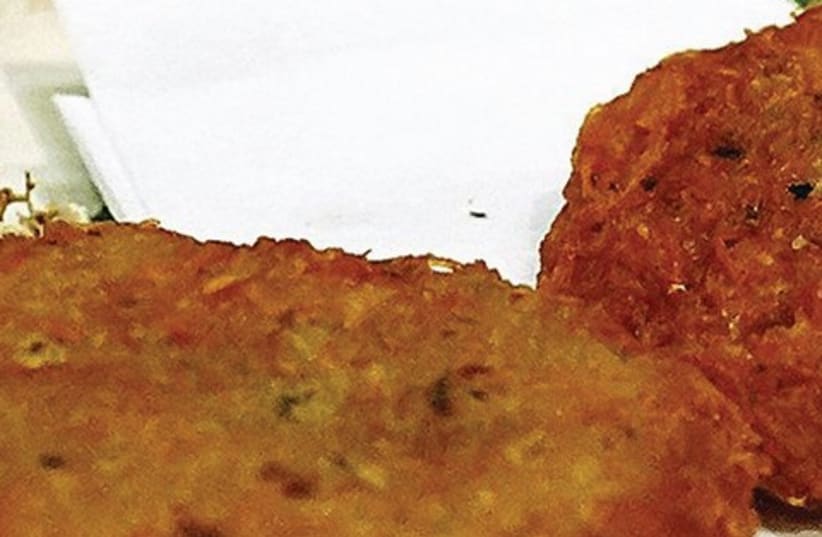NORTH AFRICAN POTATO CASSEROLE WITH TURKEYMa’akoud, which we think of as North African kugel, is cooked or baked in a pan heated with oil and served in slices. You can serve it as a side dish or as a light main course.Makes 4 to 6 servings in a standard menu, or 8 servings as part of large menu❖ 900 gr. (2 pounds) white potatoes, scrubbed ❖ 1 medium carrot (about 110 gr. or 4 ounces), peeled, halved crosswise ❖ 1 cup frozen peas ❖ 4 Tbsp. olive or vegetable oil❖ 2 large onions (450 gr. or 1 pound total), chopped ❖ 6 large eggs ❖ ¼ tsp. turmeric ❖ 1 tsp. salt ❖ ½ tsp. ground black pepper ❖ ½ cup chopped parsley ❖ 1 cup diced cooked turkey or chickenPreheat oven to 175ºC (350ºF). Put potatoes and carrot in saucepan, cover with water and add a pinch of salt. Bring to a boil and cook about 20 minutes or until carrots are tender. Remove carrots with a slotted spoon. Cook potatoes 10 minutes more or until tender. Remove potatoes.Add peas to liquid in saucepan and cook for 1 minute or until thawed. Remove from pan. Dice carrots.Heat 3 tablespoons oil in a large skillet over medium heat, add onions and sauté until they begin to brown, about 20 minutes.Peel potatoes and finely mash with potato masher. Add eggs to potatoes one by one; beat well after adding each. Stir in turmeric, 1 teaspoon salt, pepper and parsley. Taste and adjust seasoning. Lightly stir in turkey, carrots and peas.Heat remaining 1 tablespoon oil in a 2-liter (2-quart) casserole in the oven for 2 minutes or until hot. Remove with pot holders and swirl casserole carefully so oil coats sides. Carefully add potato mixture; do not mix in oil from sides of pan. Bake 50 minutes or until a knife inserted in center comes out dry. Serve hot, at room temperature or cold.SPICED PUMPKIN COMPOTEThis recipe is from The Artisan Jewish Deli at Home. Authors Zukin and Zusman usually serve the compote as a topping for cheese blintzes.For Hanukka it also makes a good accompaniment for unfilled sufganiyot. If you would like to use the compote as a filling for sufganiyot, Zukin recommends pureeing all of the pumpkin (instead of half of it) so the mixture will be smooth.You will have leftover syrup from poaching the pumpkin. Use it like any other syrup or honey, said Zukin, for example drizzled over ice cream, oatmeal, pancakes, French toast or waffles.The compote keeps up to 1 week in a covered container in the refrigerator.Makes about 3 cups; about 6 to 8 servings as an accompaniment, enough to top 12 blintzes, or enough to fill 40 or more sufganiyot❖ 3 cups sugar ❖ 4 cups coarsely chopped pumpkin or butternut squash ❖ 2 tsp. ground nutmeg❖ ¼ tsp. ground ginger ❖ 1/8 tsp. ground cloves ❖ Pinch of kosher saltCombine the sugar and 3 cups water in a medium saucepan over medium-high heat.Bring to a simmer and cook without stirring until the sugar dissolves, about 10 minutes.Add the pumpkin, nutmeg, ginger and cloves.Stir to mix in the spices, and bring back to a boil. Decrease the heat to medium-low and simmer uncovered until the pumpkin is soft but still holds its shape, about 15 minutes.Gently drain the pumpkin, reserving the syrup.Return half of the pumpkin to the saucepan along with 1 cup of the syrup and add a pinch of salt.Bring to a boil, cover, reduce the heat to low, and simmer the pumpkin until very soft, about 10 minutes.Transfer the mixture to a blender and puree until smooth. The puree should be thinner than gravy but thicker than heavy cream. Add more of the reserved syrup if the puree is too thick.Combine the remaining cooked pumpkin with the puree. Cool to room temperature, and then cover and refrigerate until ready to serve.
A Hanukka of latkes and turkey
This year's dual holiday, which has been dubbed Thanksgivukka, is an opportunity to have fun combining foods from both holidays in creative ways.
